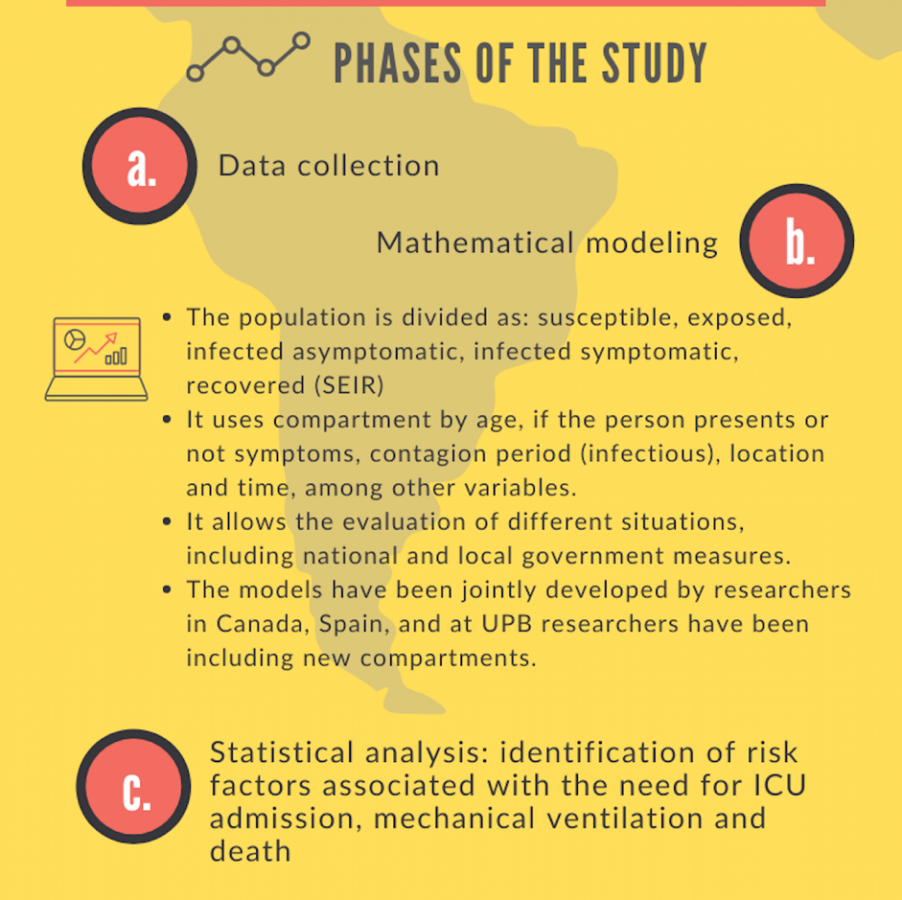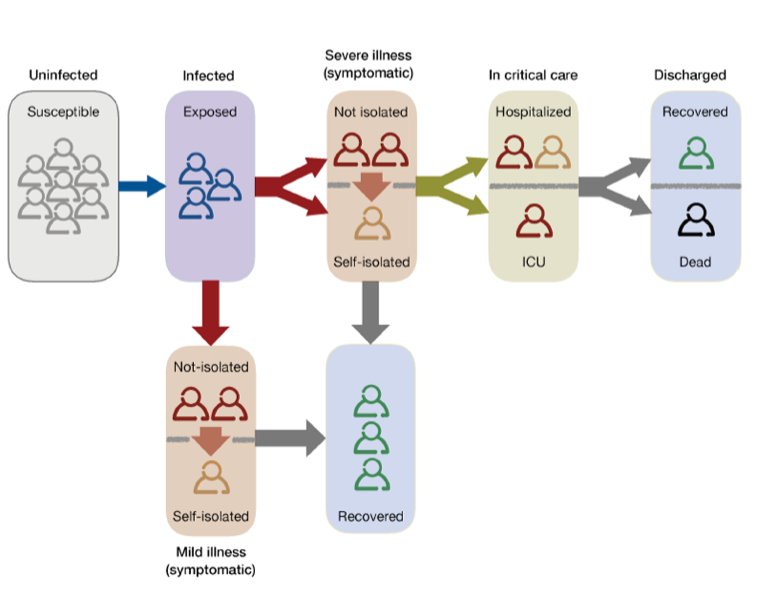UPB News Agency – Medellín (COL). Researchers from the Pontificial Bolivarian University (UPB), with officials from the Health Secretariat of Medellín, review modeling scenarios weekly to adjust the actions and plans of the city, in relation to the pandemic.

This group, led by Dr. Zulma Rueda, PhD in Epidemiology, has been actively working with researchers from the School of Engineering, Social Sciences and Health at UPB, with colleagues from Canada (University of Manitoba, York University, and National Collaborating Center for Infectious Diseases) and Spain (University of Zaragoza and Universitat Rovira I Virgili).
“We have worked intensively these past weeks. We have met with the Emergency Network, and other groups of professionals. It has been very interesting teamwork. The exercise is divided into two components: a team works to predict the number of cases, when the system would be saturated and when the peak of cases and the need for admission to intensive care units would occur. Another group works to identify risk factors for complications and death in health. This last group is led by researcher Lucelly López, UPB professor, expert in statistical analysis of this type”, explains the epidemiologist and associate professor, Zulma Rueda.


The modeling adapted and updated by UPB provides policy makers with various perspectives about the situation, while world researchers work to find the cure for COVID-19. Medellín stands out today in Colombia and in Latin America for the way it has managed the pandemic. One of the tools the city has used for this is technology. With a platform called Medellin Me Cuida, the city plans and monitors its actions. UPB and other universities provide information on different models so that the Mayor’s Office has different scenarios on the COVID-19 situation, which allows the Mayor and his team to plan strategies in the city.
In addition to the modeling component, the project called Mathematical spatial-temporal modeling of the spread of COVID-19 in Medellín: Map of risk, prediction and possible strategies to deal with the pandemic, and identification of risk factors associated with complications, need for hospitalization, ICU admission, mechanical ventilation and death, includes a strategy related to educommunication, aimed at the social appropriation of data knowledge. At the forefront of this line is the researcher Beatriz Elena Marín-Ochoa, who, with engineer Óscar Sánchez-García, proposes communicational and educational strategies on two strategic components, training and appropriation with the articulation of the scientific divulgation program of the University.
The researchers
If this pandemic has proven something, it is that interdisciplinary research and open science are the ways. This UPB project, besides interdisciplinarity, demonstrates the positive aspects of inter-institutional exercises. In this regard, Laura Lotero-Vélez, who is in charge of the team that works with the models used by the Zaragoza and Rovira I Virgili Universities in Spain, affirms: “I consider that interdisciplinary work is key to solving this type of problem; from engineering and exact sciences we can contribute to the creation of mathematical models that allow simulating scenarios that support decision-making, but the support of doctors, epidemiologists and others is vital, since they are the ones who know in detail the phenomenon behind the virus. Interdisciplinary work is synergistic”.


Given the size of the project, the team was organized as follows:
The epidemiological and clinical parameters are led by Zulma Rueda and Yoav Keynan from the University of Manitoba, who, based on a permanent review of the literature and follow-up on the data published daily by the Colombian National Institute of Health, take and update the information required to incorporate into mathematical models. They compiled and prepared a diagram with the information of what in epidemiology is known as “natural history of the disease”, which includes the clinical and epidemiological aspects of COVID-19, necessary to carry out the modeling.
Mathematical models:
The Spanish model is led by engineer Laura Lotero-Vélez, who has dedicated herself to studying how mathematical models help to better understand how people move in the city. “I focused my doctoral work on the effect that the fact that we are mobile beings could have in a diffusive process such as the spread of a contagious disease. That made me familiar with the topic of epidemics from an engineering and exact science perspective,” she explains. She works hand in hand with Jesús Gómez-Gardeñes, from the University of Zaragoza and the team from Spain.
The Canadian and American model is led by Roberto Hincapié-Reyes and Diego Muñoz-Durango, who reviewed and studied articles published in those countries. In a collaborative exercise, UPB professors wrote their own codes after studying and analyzing the codes used in Canada and the United States. Muñoz-Durango says that “based on this information, we proceeded to assemble our own codes to include particularities of Medellín and to have the possibility of simulating what the city’s Health Secretariat requested of us. Two types of models were implemented based on the information provided: a first dynamic transmission model structured by age in which the inhabitants of Medellín are divided into 4 age ranges and a second model based on agents and structured by age where each inhabitant from Medellín is an agent”. This team works with Professor Seyed Moghadas of York University.
This way, the University puts all its capacity at the service of leaders to leverage decision-making from their expertise, which today more than ever, impacts all aspects of citizens’ lives.
The model includes around 20 sociodemographic and clinical variables, with weekly updates and calibrations to generate more accurate predictions and adjusted to the transmission patterns of the infection and the measures taken by governments.
The selected model was worked by the professor Roberto Hincapié-Reyes and allows to include more information, predicts more precisely what is wanted and provides quite detailed information.
“We are an interdisciplinary group of epidemiology, statistics, engineering, mathematics and applied computational modeling in epidemiology, public health, biocomputing and physics of complex systems, infectious diseases and critical care with extensive experience in statistical modeling and analysis (…) in infectious diseases that are looking to contribute to public health decision-making”, explains Zulma Rueda, who leads this project.
Read here the full article in Spanish
By Claudia Patricia Gil Salcedo, Scientific Divulgation – UPB News Agency
